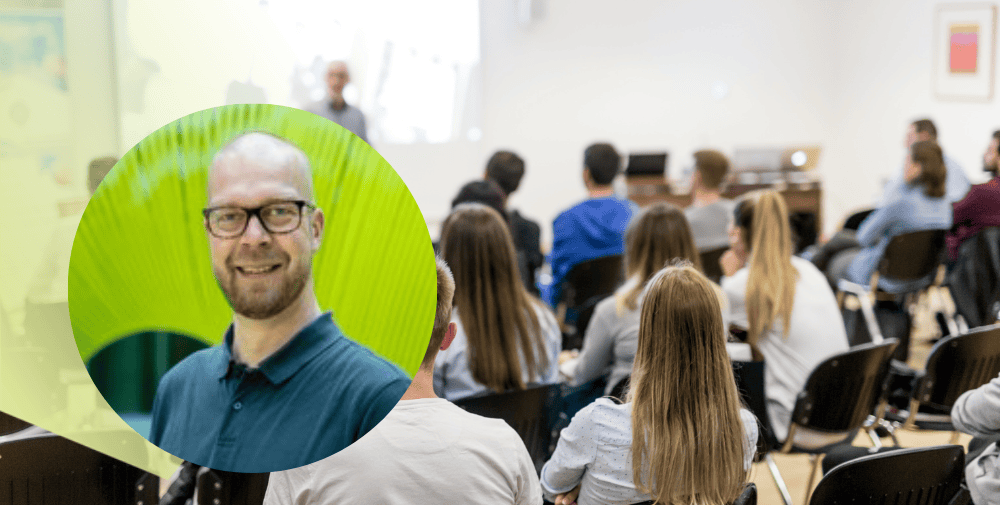What position do you currently hold and what are the tasks and areas of responsibility behind it?
Wolf Spalteholz: I am a university teacher and therefore employed in the Free State of Saxony. However, I am seconded to the TU Dresden with 100% of my working time and am a teacher at the Center for Teacher Education, School and Vocational Training Research (ZLSB). In this role, I accompany students of the teaching profession during practical school exercises (SPÜ). SPÜ are students’ first attempts at teaching in schools and in front of pupils. During these first teaching units, we provide the students with didactic support and prepare them for the Block B internship. During this, the students then go into schools for four weeks. Here, they accompany, design, develop and deliver longer teaching sequences and are supported through observation and seminars. Another aspect of my work is teaching in the so-called supplementary area. In my case, this mainly involves the area of digitalization and the specific computer science training of teachers.
So you also have a direct influence on the further development of computer science teaching in Saxony?
Wolf Spalteholz: Mainly, my work focuses on the implementation of courses and SPÜ for students. For the curriculum commission or as an active subject advisor, however, it was also about the further development of the subject of computer science.
You completed your “Higher Teaching Qualification at Grammar Schools” for the subjects of mathematics and computer science in 2009. What did your studies – especially in computer science – look like back then and how have teacher training programs changed since then?
Wolf Spalteholz: Compared to my other subject – mathematics – and many other subjects that I had an insight into through my fellow students at the time, the didactics team in computer science is relatively small. That sounds like a disadvantage, but in my eyes it’s an advantage. As a student teacher of computer science, you are and have always been very well supported. Many courses in computer science were then and still are tailored to the needs of student teachers. To pick out one example: the Databases course. This course is attended by many computer science students and has a very strong technical focus. Which is right, because professional competence is crucial for teachers. For student teachers, however, it is of course not possible to go into how to implement a topic such as databases in schools in such depth. There are separate courses for this that deal specifically with didactics. And it is precisely this combination that I think is worth keeping. The focus is on professional competence. The specialization in didactics and the proximity to schools ultimately helps students to transfer this specialist knowledge.
4. In your opinion, is the training of teachers optimal – especially with regard to the use and integration of digital formats and tools or with regard to improving students’ digital skills?
Wolf Spalteholz: I am very pleased that the universities offering teacher training in Saxony have now incorporated mandatory “media education” modules that deal with all digitalization-related skills into the university curricula as part of the supplementary area for all teacher training students. This helps to strengthen digital education and digital skills outside of computer science, as they have been anchored in all subjects. Regardless of which teaching profession you are studying, you must, or rather may, deal with this range of topics in the first phase of teacher training. Due to the large number of students – teacher training students are the largest student group at TU Dresden – the design of these courses is of course still a major challenge that needs to be mastered in the coming years. Last year, the first students were enrolled who are studying according to the new study regulations and now have these media education modules as compulsory modules in the supplementary area. This was long overdue.
Germany performed disappointingly in the PISA study. Saxony is supposedly the “one-eyed among the blind” in a comparison within Germany. What is the Free State currently doing right in the field of education?
Wolf Spalteholz: Saxony was one of the first federal states to offer a continuous computer science education from year seven to ten, which has long been a compulsory part of general education for all pupils in all types of schools. In grades 5 and 6, the subject “Technology and Computers” is also part of the curriculum. This means that from year 5 with basic computer science education, computer science lessons up to year 10 and the courses offered in the Abitur, we have a continuous computer science education in all types of schools in Saxony.
In the recent past, the first basic computer science skills – “pre-computer science education” – have also been integrated into the primary school curricula. Since 2022/23, we have also had an advanced computer science course at mainstream grammar schools. Previously, this was only available at vocational grammar schools. With these offerings, Saxony is excellently positioned nationally – as the G.I. Computer Science Monitor has shown time and again.
The technical infrastructure is also well organized in the Free State. With Lernsax, Schullogin and the underlying tools, we have digital tools that help in school practice. Whether web conferencing tools, cloud, learning management systems or communication platforms – with the single sign-on school login, we connect all pupils, parents and teachers in Saxony.
In teacher training, I would emphasize the opportunities for lateral entrants. This option is available in many subjects, including computer science. We are way ahead of the rest of Germany in this area. Since 2018, and in the case of computer science since 2019, new groups of lateral entrants have been starting their two to two-and-a-half-year training every year, including here at TU Dresden, and this is well structured and organized – including by the ZLSB.
Not least, the current training of students on all teacher training courses in the areas of “media education” and “digitalization” must be emphasized once again.
The continuous computer science education from elementary school to secondary school, the technical infrastructure, the lateral entry into the teaching profession and the adapted training of future teachers are the four decisive points that put Saxony in a very good position.
And where do you still see digital development potential in Saxony’s educational institutions?
Wolf Spalteholz: Here I am looking primarily at the area of digitalization-related skills and not so much at the subject of computer science. By resolution of the Saxon Ministry of Education and Cultural Affairs, digitalization-related skills are a cross-sectional task for all subjects. This decision alone should be seen as positive, but it poses a huge challenge for schools on a day-to-day basis. In times of teacher shortages and especially a shortage of teachers in STEM subjects, there is often a lack of scope for teacher training and further education. Accordingly, the actual implementation of this requirement – i.e. also teaching digital skills in mathematics, biology, history, sport, etc. – is not so easy to implement.
I would like to see the gap between the political commitment to more digitalization in schools and digitalization-related skills in all subjects and the institutional, human and material resources we have available in schools closed. This is the only way that what has rightly been decided and is really important can also be implemented in schools.
After all, every subject has intersections with digitalization, regardless of whether it is a natural or social science, language, sport, art or music. We must not neglect this potential. There are already very good lighthouse projects in these areas. There are many colleagues who are doing a great job here. The best thing we can do is to collect all these approaches and spread them across all schools so that this cross-sectional task is not only perceived, but also implemented.
You were a computer science teacher for a long time. Later, you were subject coordinator and subject advisor for this area. Is German/Saxon computer science teaching currently fit for the future or internationally competitive?
Wolf Spalteholz: Computer science teaching in Saxony is internationally competitive. Is it also fit for the future? We are talking about developments that affect all of our lives, but are often less than half a lifetime old. This means that there is no definitive assessment of what is and isn’t part of the subject matter.
The best solution here seems to be to focus on the so-called timeless principles of computer science and integrate these into the curriculum. This means, among other things, thinking carefully about trends and developments in computer science and considering whether they should be taught – i.e. whether they are timeless. A current example of this is the topic of artificial intelligence (AI). Which aspects of AI should be incorporated into the curriculum on a binding and permanent basis? Which aspects are left up to the teachers to decide? It is important to find a balance between committed and largely free teachers and a binding curriculum. For my part, I am convinced that we have developed a good new curriculum for all types of schools in Saxony that still gives teachers the opportunity to set their own priorities.
High technology and the digital sector in particular are changing rapidly. How can computer science teaching keep pace with this reality and continuously improve?
Wolf Spalteholz: I wouldn’t look at computer science lessons in isolation here, but at the school as a whole. Computer science lessons are not there for Word, PowerPoint and Excel. If we leave these application skills, which are certainly needed for digital skills, exclusively to computer science lessons and deal with click instructions and product training, then we won’t move anything at all and won’t keep our finger on the pulse of the times. All subject areas are in demand when it comes to integrating digital tools into their own lessons. If this happens, computer science lessons can actually deal with the aforementioned “timeless principles” of computer science. It is then up to the individual teachers who teach computer science to illustrate these operating principles using current technologies and examples or to integrate exciting tools into their own lessons. This is motivating. It has an everyday relevance. It’s current and therefore interesting for children and young people. And it also allows us to keep pace with high technology and the digital industry.
You have clearly stated that computer science lessons are not solely responsible for the digital education and digital skills of our young people. But how can we improve interdisciplinary interaction in this area?
Wolf Spalteholz: This is a major part of my research work. Thinking about how to find out what digitalization-related skills need to be developed outside the subject of computer science. I had a suitable example to hand just now. It was about the “appropriate use of search engines”. How should a teacher put this formulated digital competence into practice? Let’s imagine a history lesson, for example. The teacher hands out the available tablets, which are logged into the existing Wi-Fi and then says: “Now let’s all search for how the Nile flooded the fields in ancient Egypt and what positive and negative effects this had.” The students use an application, in this case a search engine. However, this does not mean that the students build up skills in this area. Only when it is discussed how a search engine works, how to optimize search queries, which search request is specifically behind the question asked and which criteria are used to evaluate or further improve the results, do we build competence. The Saxon competence framework is good. It describes these digitalization-related skills in general terms, as befits a skills framework. However, transforming these possibilities into concrete terms in schools is a task that awaits us in the coming years. We need to teach teachers what can, what should and what must be done digitally in each individual subject? And if digital skills are ultimately also the responsibility of other subject areas, then they must also be assessed here.
What needs to be done to integrate new technologies even better and more effectively into different teaching formats?
Wolf Spalteholz: In short: create the right framework conditions. On the one hand, this means offering teachers appropriate training. On the other hand, it also means organizing the necessary freedom for colleagues to participate in times of high stress caused by the current shortage of teachers. That sounds simple, but unfortunately it is not. After all, professional training in digital skills must be followed by pedagogical training or both must be combined in a training course. After all, understanding and being able to use a technology does not mean that I can impart this knowledge to students. This is referred to as digital pedagogical content competence. It is important to find the right approach for every subject area and every type of school. With the rapid development of new technologies and the establishment of new digital tools, this is a challenging task.
What role do AI tools such as ChatGPT, DeepL, Dall-E or Beautiful.ai play in the current curriculum and how are students familiarized with their use?
Wolf Spalteholz: Yes, AI tools play a role. There are learning areas in computer science lessons that deal exclusively with artificial intelligence. This is particularly pronounced in the advanced computer science course. The challenge in this area is that a deep understanding of the technical background is necessary to understand how AI tools work. School cannot provide this. On the other hand, the basic principles of machine learning can be made relatively easy for fifth or sixth graders to understand. These functional principles, without looking deep into the systems, can already explain how machines learn. And on this basis, it is then possible to discuss the social or cultural aspects of AI systems, among other things. What is far more difficult is the application level. Where can we work with AI tools at school? Where do they support students and teachers? How do we have to set tasks, e.g. for annual assignments or exams, so that AI tools provide support but do not take over the students’ thinking? We first have to find suitable ways to do this.
Basically, once I have learned to calculate, a calculator helps me to do the math faster. A computer helps me to automate things so that they are done faster. So why shouldn’t I also use AI tools for things that can be automated in this way? This does not necessarily mean that the underlying skills are no longer developed. Even the discussion about the use of calculators in math lessons has not meant that we no longer teach and therefore understand basic arithmetic.
It is not uncommon to hear complaints about the lack of female applicants in the STEM field – regardless of whether they are studying or working. Is there a difference between girls and boys in STEM education? And if so, how can it be resolved?
Wolf Spalteholz: The absurd thing about this discussion, which comes up again and again and is dealt with in numerous scientific articles, sometimes very well, sometimes less well, is that it does not correlate with what I experience and have experienced as a teacher, especially in computer science lessons. I can’t see any difference in what female students achieve compared to male students. This is also well documented scientifically. I can hardly see any differences in terms of motivation either. Why students in STEM fields are more often men than women can therefore not be explained by findings from schools.
Does the importance of the microelectronics and ICT sector for Saxony play a role in the Saxon curriculum?
Wolf Spalteholz: This knowledge does not belong in the curriculum. In order to provide good lessons and fulfill the educational mission in the best possible way, it always makes sense to include the local strengths and players in the classroom.
Thank you very much for the interview.
_ _ _ _ _ _
Further links
👉 Digital pedagogical content literacy
👉 Using search engines appropriately
_ _ _ _ _ _
Our interview partner
Wolf Spalteholz
Teacher in higher education
Professorship for Didactics of Computer Science
T: +49 351 463-42155 | M: wolf.spalteholz@tu-dresden.de
_ _ _ _ _ _
This interview was conducted as part of NEXT “In the spotlight: Software”.
👉 To the complete issue of the magazine



